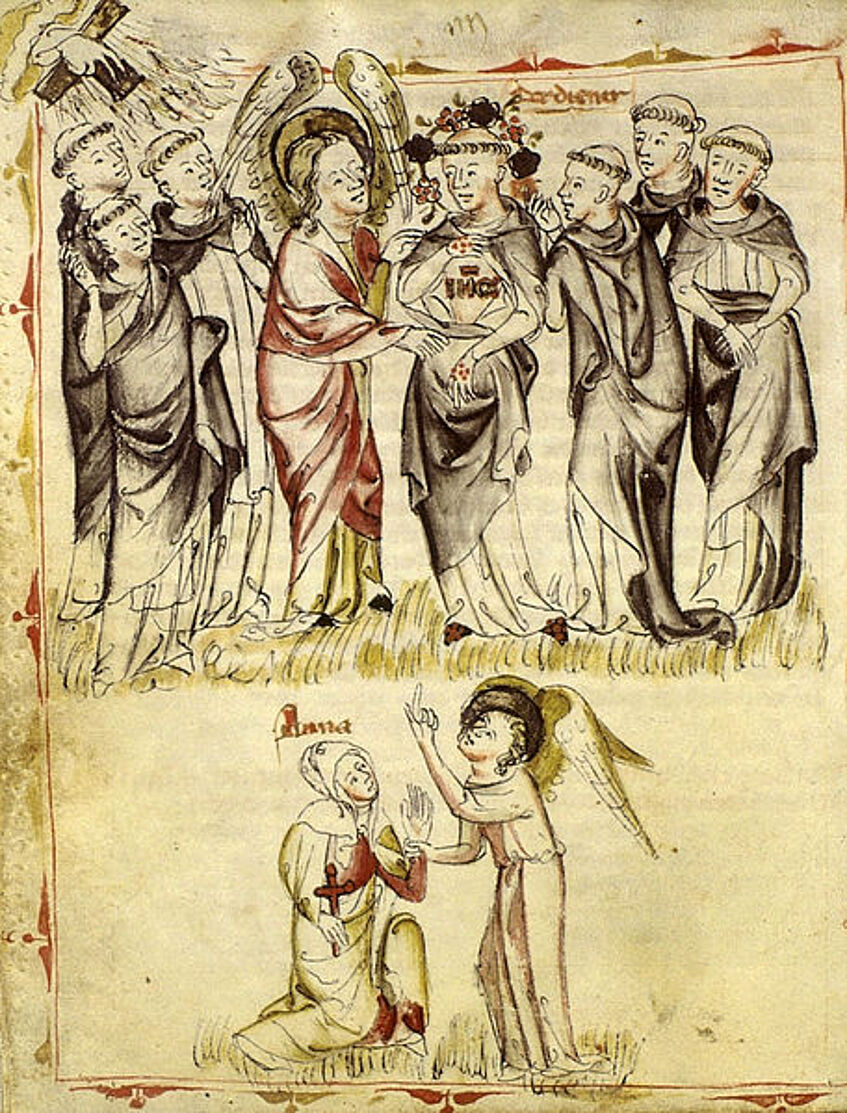
BNU Strasbourg, MS 2929, Vie du Bienheureux Suso, f. 62 (Public domain, via Wikimedia Commons)
FWF Stand Alone Project (P 36750-G)
July 2023-June 2027
Henry Suso (d. 1366) was one of the most influential mystical writers of the later Middle Ages and the subject of numerous recent studies by scholars of art, gender and spirituality. His many texts encouraged their readers to detach themselves from the everyday world so that they could be spiritually joined to God in contemplative prayer. However, despite his stark warnings about the temptations of the material world, his most famous work, The Exemplar, is filled with colourful descriptions of miraculous spaces, places and objects.
This strange paradox is the subject of this project. It explores how Suso used space as part of his mystical, intellectual and literary strategies, to explain, justify and enliven his spiritual instruction. This project will understand Suso as developing a mystical and spatial programme with a long history in Christian thought, but which had been most recently and most radically expressed in the work of his influential teacher, Meister Eckhart. It will then contrast Suso’s thought with that of his contemporaries, including writers such as Johannes Tauler, Johannes von Dambach, Rulman Merswin and Elsbeth Stagel.
The project will also place his work in the context of contemporary religious practice, spatial regulation and architectural organisation. Suso (like Eckhart) was part of an order of friars, the Dominicans, that had been founded at the beginning of the thirteenth century and which had often been concerned with questions of architectural design and the correct use of monastic spaces. Suso spent most of his life on a remarkable island friary in Lake Constance, separated from the city of Constance by a narrow moat and from which some elements still survive today. Together, these provided the ideological and material context for his reflections on space, especially in his most famous text, ‘the Life of the Servant’, the protagonist of which was also a friar who interacted in complex ways with the architecture of his friary. The project will study, in particular, Suso’s approach to the spatial experience of Dominican nuns, who were often the principal audience for his writing.
This project will not only provide new historical knowledge about Suso’s work and intellectual environment, and about late-medieval spatialisation more generally, but also develop a new theoretical and methodological approach to the study of space in medieval Europe. This is a period that long precedes the ideological concerns that have characterised modern spatial theory and requires an approach sensitive to its moral and theological imperatives. This project addresses a period dominated by social, gendered and economic inequality, and by a great intellectual and affective concern for the soul’s relationship with both the material body and a non-material God. These conditions, particular to the European Middle Ages, provide the scholarly challenge that this project will address.
Principal Investigator:
Gabriel Byng is a cultural historian who has worked on material objects, places and spaces from across European history. Before leading the Space and Spacelessness project, he held a Marie Curie Individual Fellowship at Vienna and a Research Fellowship at Cambridge, where he also completed his PhD.
He has won numerous awards, including a Dan David Prize from the University of Tel Aviv and a Reginald Taylor and Lord Fletcher essay prize, fellowships at the Herzog Albrecht Bibliothek and the OeAD, and grants from the Paul Mellon Centre, London, and the University of Chicago. His first book appeared with Cambridge University Press and he has been invited to contribute several encyclopaedia articles and to act as peer reviewer for many journals and publishers.
